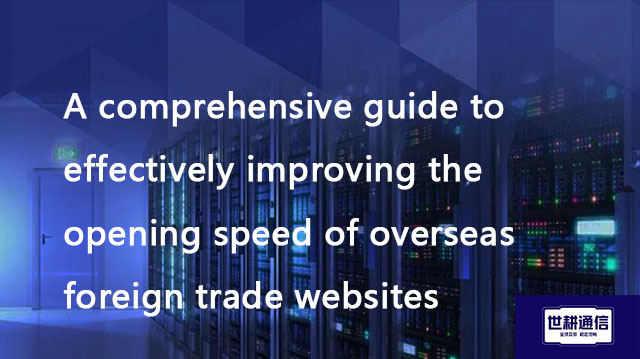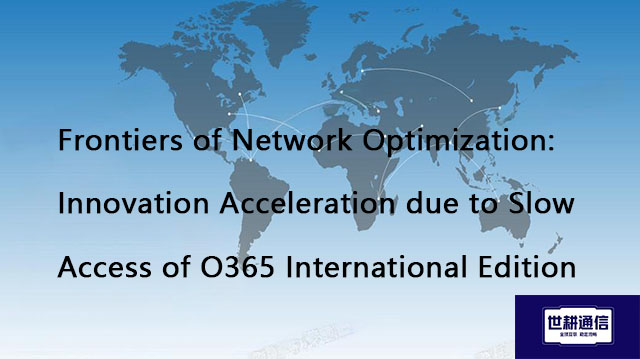A comprehensive guide to effectively improving the opening speed of overseas foreign trade websites//Global IPLC service provider of Shigeng Communication
一、In the era of globalized e-commerce, when overseas users visit your foreign trade website, page loading speed directly affects conversion rates and user experience. Research shows that 40% of users will give up websites that take more than 3 seconds to load. This article will provide a detailed introduction to 10 effective methods for improving the international access speed of foreign trade websites.
1. Choose high-quality international CDN services
Content Delivery Network (CDN) is the core solution for improving overseas access speed:
Comparison of mainstream CDN service providers: Cloudflare (cost-effective), Akamai (enterprise level), AWS CloudFront (integrated with AWS ecosystem)
Configuration points: Ensure that static resources (images/CSS/JS) are distributed through CDN and set reasonable caching rules
China specific optimization: If the target market includes China, it is necessary to choose a CDN with an ICP license, such as Alibaba Cloud CDN or Tencent Cloud CDN
2. Optimize website hosting and server location
The server's geographical location directly affects latency:
American users: It is recommended to use data centers in the eastern (Virginia) or western (California) regions of the United States
European users: Frankfurt or London data centers can provide better coverage
Asian users: Singapore node is suitable for Southeast Asia, Tokyo node is suitable for East Asia region
Cloud service recommendation: Region selection for AWS, Google Cloud, or Azure should match the primary customer base
3. Simplify and optimize website code
Code optimization can significantly reduce the amount of transmitted data:
CSS/JS compression: using tools such as Webpack and Gulp to merge and compress files
Remove redundant code: Regularly audit third-party plugins and unused code repositories
Asynchronous loading: Non critical JS uses the asynchronous/delete property
Latest technology: Consider using WebP image format and HTTP/2 protocol
4. Intelligent Image Optimization Strategy
Images are often the main cause of slow loading:
Format selection: Use WebP for product images (25-35% smaller than JPEG), and SVG for simple graphics
Responsive image: Use the srcset attribute to provide appropriate sizes for different devices
Lazy loading: Implement image viewport loading, prioritize loading the first screen content
Example tools: TinyPNG, ImageOptim, or ShortPixel batch optimization
5. Database and backend optimization
Backend performance is equally critical:
Database indexing: Ensure that commonly used query fields have been indexed
Cache strategy: Implement Redis or Memcached object caching
Query optimization: Avoid N+1 query issues and regularly clean up useless data
Hosting options: Use managed database services such as AWS RDS
6. Reduce the number of HTTP requests
Each request increases latency:
Merge Files: Merge multiple CSS/JS files
Sprite technology: using CSS Sprite for small icons
Inline key CSS: First screen key styles are directly embedded in HTML
Font optimization: Only load the font weight and character set used
7. Enable browser caching
Reasonably utilize local cache:
Cache header setting: Static resource setting expires after 1 year (with hash version control)
Service Worker: Implement offline caching capability
CDN caching rules: Configure cache duration for different resources
8. Using preload and pre connect techniques
Establish key connections in advance:
DNS Prefix: Pre DNS Resolution for Third Party Domain Names
Preconnect: Establish a TCP connection in advance
Preload: Mark key resources to be loaded first
Prefetch: Predictive loading of next page resources
9. Monitoring and continuous optimization
Speed optimization is a continuous process:
Monitoring tools: Google PageSpeed Insights, WebPageTest, Pingdom
Performance benchmark: Establish a KPI for loading time and conduct regular testing
User feedback: Collect speed experience reports from actual users
A/B testing: comparing the effects of different optimization schemes
10. Special optimization for specific regions
Different regions require different strategies:
China optimization: filing domain names, using domestic CDN nodes, reducing dependence on Google services
Middle East optimization: Consider local hosting and optimizing Arabic content separately
Emerging markets: Simplified versions designed for low-end devices and slow networks
conclusion
Website speed optimization is a system engineering that requires collaboration from all levels of the technical stack. For foreign trade enterprises, investing in website speed means investing in customer experience and conversion rates. Suggest starting with quick and effective aspects such as CDN deployment and image optimization, and gradually delving into code and architecture optimization. Remember, in global competition, every millisecond of acceleration may bring additional business opportunities.

二、Shigeng Communication Global Office Network Products:
The global office network product of Shigeng Communication is a high-quality product developed by the company for Chinese and foreign enterprise customers to access the application data transmission internet of overseas enterprises by making full use of its own network coverage and network management advantages.
Features of Global Application Network Products for Multinational Enterprises:
1. Quickly access global Internet cloud platform resources
2. Stable and low latency global cloud based video conferencing
3. Convenient and fast use of Internet resource sharing cloud platform (OA/ERP/cloud storage and other applications
Product tariff:
Global office network expenses | Monthly rent payment/yuan | Annual payment/yuan | Remarks |
Quality Package 1 | 1000 | 10800 | Free testing experience for 7 days |
Quality Package 2 | 1500 | 14400 | Free testing experience for 7 days |
Dedicated line package | 2400 | 19200 | Free testing experience for 7 days |







